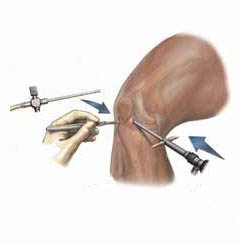Arthroscopy procedure / surgery

What is Arthroscopy
A MINIMALLY INVASIVE SURGERY procedure that allows an orthopedic surgeon to view the inside of a JOINT using a lighted, flexible endoscope adapted for this use, called an arthroscope. Arthroscopy, also called arthroscopic surgery, has both diagnostic and therapeutic applications. Inserted into the joint through a small incision, the arthroscope has a tiny camera at its tip that sends images to a monitor. The orthopedic surgeon manipulates the arthroscope and specially designed instruments to examine the joint and repair damage to CARTILAGE, LIGAMENT, TENDON, and other tissues. Arthroscopy has largely replaced OPEN SURGERY for most operations on the joints except JOINT REPLACEMENT.
Arthroscopy - Surgical Procedure
The orthopedic surgeon performs arthroscopy in a hospital operating suite or an AMBULATORY SURGERY facility. Most arthroscopies are same-day (outpatient) procedures, with the person arriving a few hours before the scheduled arthroscopy and going home a few hours after the surgeon completes the procedure. ANESTHESIA may be regional (a NERVE block that numbs the limb) or general (puts the person to sleep). The orthopedic surgeon makes two or more small incisions around the JOINT: one for the insertion of the arthroscope, one for insertion of the irrigating catheter, and others for insertion of the arthroscopic instruments. Most arthroscopic procedures take 20 to 60 minutes.
After the arthroscopic operation, the person rests in the recovery area until the anesthetic is fully worn off and the person is comfortable enough to go home. Generally the person receives mild to moderate ANALGESIC MEDICATIONS for PAIN relief, depending on the extent of discomfort he or she feels. Because the entry into the joint is minimal, many people experience little discomfort or pain after the procedure.
Arthroscopy - Risks and Complications
As with any surgical procedure, arthroscopy has a risk for excessive bleeding and INFECTION. However, these complications are uncommon. Soreness and bruising at the incision sites is common though usually mild. When the arthroscopic examination reveals more extensive damage than the orthopedic surgeon can repair arthroscopically, the operation may become an open surgery with longer recovery and rehabilitation periods.
Outlook and Lifestyle Modifications
Most people recover from arthroscopic procedures fully and without complications, returning to their regular activities within several days to two weeks, depending on the surgeon’s recommendation and the type of procedure. Arthroscopic procedures generally repair injuries that have limited the person’s mobility or function, so most people are much improved after their operations and may return to activities their injuries had prevented them from performing.
See also ENDOSCOPY; MENISCECTOMY; SURGERY BENEFIT AND RISK ASSESSMENT.
Open discussion on the topic Arthroscopy procedure / surgery
Similar interests
- Nuovi Casino
- Casinos Not On Gamstop
- UK Casinos Not On Gamstop
- Casinos Not On Gamstop
- UK Casinos Not On Gamstop
- Casino Non Aams Italia
- Slot Sites Not On Gamstop
- Meilleur Casino En Ligne
- Non Gamstop Casino Sites UK
- Meilleur Casino En Ligne
- Casino En Ligne France
- Best Non Gamstop Casinos
- Casinos Not On Gamstop
- UK Casino Not On Gamstop
- Casinos Not Signed Up To Gamstop
- Best Slot Sites UK
- Non Gamstop Casino Sites UK
- Online Casinos Nederland
- Online Casinos Nederland
- Casinos Not On Gamstop
- Best New Uk Casinos Not On Gamstop
- Casino Non Aams
- Non Gamstop Casinos UK
- Migliori Siti Casino Non Aams
- Bitcoin Casinos
- Sites De Paris Sportifs Belgique
- Bookmaker Non Aams
- Casino En Ligne